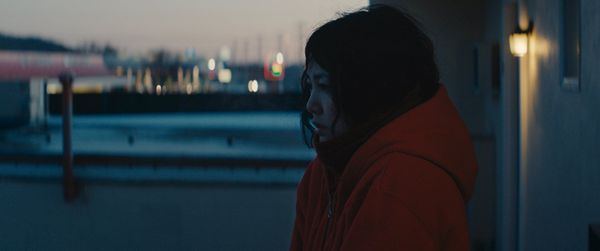Eye For Film >> Movies >> Kumiko, The Treasure Hunter (2014) Film Review
Kumiko, The Treasure Hunter
Reviewed by: Owen Van Spall

A project that took a long time to get off the ground (the filmmakers joked during the Sundance London Q&A that Japanese actor Rinko Kikuchi was fluent in English by the time the shoot actually wrapped), Kumiko The Treasure Hunter actually arrives at a strangely convenient time for the filmmaker brothers David and Nathan Zellner. Given that the plot concerns a reclusive and withdrawn young Japanese woman obsessed with the Coen Brothers film Fargo, it is an odd coincidence that the FX channel just so happens to be airing a new TV series spin off based on that very same film right now in the US (it airs on C4 in the UK). The plot was inspired by an urban legend about a Japanese woman who took a similar journey, and this seems like a real life story the Coens would adapt themselves too if the Zellners had not got there first.
This isn't really an attempt by the Zellners to ‘do a Coen film’ however, and though they shoot the US-set sections of this film in the same Minnesota locations the Coens have explored many times, they admit to not particularly looking to ape the brothers’ signature style. Though their use of the striking wintry landscapes and the eccentric midwestern Americans populating them inevitably hark back to the Coens, the jarring sight of Kikuchi wandering alone there evokes another recent picture about alienation: namely Johnathan Glazer’s Under The Skin.

We actually begin the film in contemporary Tokyo, where we meet the quiet Kumiko (played by Kikuchi, who was recently seen in the Guillermo de Toro blockbuster Pacific Rim). She lives in a cluttered, cramped apartment in Tokyo with only her pet rabbit, Bunzo, for company. The phone calls we see her reluctantly take from her mother end up more like browbeating sessions than family catch-ups. Kumiko’s job involves demeaning work as an ‘office lady’ (her boss’ words), preparing tea and fetching his dry cleaning in between his tactless pep talks. As played by Kikuchi, Kumiko walks and talks like she is underwater, slow and shuffling, or lost in a fog. Only her bright red hooded jacket makes her stand out in the crowd.
But we soon see that a vivd - maybe too vivid - imagination is raging inside. Kumiko is caught up obsessively in watching the Coen Brothers' black comedy thriller on a battered VHS tape. How she got this tape isn't clear: a possibly-imagined opening scene shows her unearthing it in a cave, like some kind of buried treasure. Rewinding and fast-forwarding it until it mangles her player, Kumiko meticulously maps out where the briefcase of castaway loot featured in the film’s opening sequence must be buried in the actual USA. The fact that the film’s ‘based on a true story’ opening text is completely tongue in cheek is lost on her. After hours of intense preparation which involves stealing an atlas from a library, knitting a map and swiping her boss’s company credit card, Kumiko heads to the United States and into the harsh Minnesotan winter to try to get to Fargo and search for the loot. All she can explain to the baffled Midwesterners she runs into in her few phrases of broken English is that she is a treasure hunter like the Conquistadores of old, and this is her destiny.
Never offscreen, Kikuchi is the lynchpin of the film and acquits herself well, though perhaps the intense and inward performance feels a little mannered at times. Kumiko is actually such a withdrawn figure with so little context provided for her situation that it feels like the film is determined to keep you at a distance. Overall though, the Zellners have put together a strikingly shot and tonally very intriguing film (praise is due to DP Sean Porter), though one that will probably only appeal to a limited crowd. Though the concept might make the film sound like a kind of reverse Lost In Translation, Kumiko’s tale is more of a tragic story. Her journey might have plenty of laugh out loud culture clash moments (such as when a kindly local sheriff takes her to a Chinese restaurant blindly assuming the owners will speak Japanese), but this is still a study of a person deeply unable to adjust to anything like regular life. Her trip to the US, made with literally no preparation on any practical level, involves her essentially throwing what was probably her only chance at a stable job away and criminalising herself through theft. As she heads deeper into the primeval Minnesotan winter, even her life is ultimately put at risk (it's no place to be wandering around in a parka and sneakers).
Yet the Zellners seem to see a kind of poetic nobility and beauty in such an effort too, in the act of pursing one’s dreams no matter that they are attainable only in the confused mind of one deeply lonely person. Maybe this is a wider comment on the art and power of movie making itself, given that it is the riches conjured up on screen that drive Kumiko. As Kumiko’s journey takes her deeper into Minnesota, the breathtaking ‘Americana’ landscapes and intriguingly surreal score work together to suggest a heightened state, or a fable. Soon we are no longer certain whether we are walking beside Kumiko or have slipped into her mind.
Other meta readings along the lines of ‘films within films’ are certainly possible: one viewer piped up during the Q&A for this film that he thought Kumiko’s red coat and her grainy VHS were sly nods towards classic US and Japanese films such as Don’t Look Now and Ringu. The Zellners claimed it was unintentional, but it is an intriguing way to approach what is already a beguiling and hauntingly beautiful film.
Reviewed on: 27 Apr 2014

















